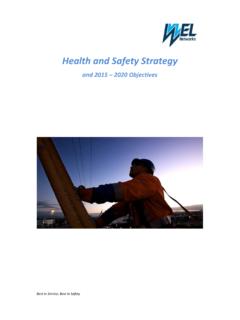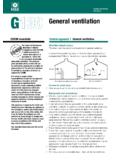Transcription of essentials - HSE: Information about health and …
1 health and safety Executive1 of 3 pagesWhat this sheet coversThis sheet describes good practice when you need to remove CAF gaskets and asbestos rope seals from pipework, vessels and plant, or heaters, boilers the gasket or seals are substantially broken up or damaged during removal then the work will be notifiable non-licensed work (NNLW) see sheet a0 Introduction to asbestos the work area Ensure safe access. Restrict access minimise the number of people present. Close doors. Use tape and notices to warn others. Ensure adequate 500-gauge polythene sheeting and duct tape Warning tape and notices Class H vacuum cleaner (BS 8520) (if available see sheet em4) to collect adhering gasket residues Scraper Garden-type sprayer containing wetting agent Bucket of water and rags Asbestos waste bag Clear polythene bagPersonal protective equipment (PPE) see sheet em6 Provide: disposable overalls fitted with a hood; boots without laces (laced boots are hard to decontaminate); respiratory protective equipment (RPE).
2 Removing compressed asbestos fibre (CAF) gaskets and asbestos rope sealsa25asbestos essentialsNon-licensed tasksEssential informationImportant: You must read sheet a0 Introduction to asbestos essentialsAlso read the following sheets:em0 Risk assessments and plans of workem1 What to do if you discover or accidentally disturb asbestos during your workem2 Information , instruction and trainingem4 Using a Class H vacuum cleaner for asbestosem5 Wetting asbestos materialsem6 Personal protective equipment (including RPE)em7 Using damp rags to clean surfaces of minor asbestos contaminationem8 Personal decontaminationem9 Disposal of asbestos waste2 of 3 pagesHealth and safety Executivea25 Removing compressed asbestos fibre (CAF) gaskets and asbestos rope sealsOther hazardsWork at height see Take precautions to avoid and trips see Floors protected with polythene become very slippery when may be other hazards you need to consider them Ensure the system has been made safe (pipework emptied, electrical supply isolated etc).
3 Protect nearby surfaces from contamination. Cover with 500-gauge polythene sheeting and fix with duct tape to non-asbestos surfaces. Protect vulnerable components with polythene Unbolt or unscrew the flange, or dismantle the equipment. Once accessible, dampen the asbestos. Continue dampening as it is exposed. Ease the gasket or rope seal away with the scraper, and place into the asbestos waste bag. Keep the surface damp, and ease away asbestos residues. Gently scrape off residues using shadow vacuuming (if available see sheet em4).Cleaning and disposal Clean the equipment and the area with the Class H vacuum cleaner (if available) and/or damp rags. Put used rags, polythene sheeting and other waste in the asbestos waste bag and tape it closed. Put the asbestos waste bag in a clear polythene bag and tape it closed. Disposal see sheet material left on a pipe flangeJoint packing on a flueString gasket between metal sheetsSome examples of rope seals found on boilers3 of 3 pagesHealth and safety ExecutiveFor Information about health and safety , or to report inconsistencies or inaccuracies in this guidance, visit You can view HSE guidance online and order priced publications from the website.
4 HSE priced publications are also available from guidance is issued by the health and safety Executive. Following the guidance is not compulsory, unless specifically stated, and you are free to take other action. But if you do follow the guidance you will normally be doing enough to comply with the law. health and safety inspectors seek to secure compliance with the law and may refer to this document is available at: Crown copyright If you wish to reuse this Information visit for details. First published as part of Asbestos essentials task manual by the health and safety Executive 09/17a25 Removing compressed asbestos fibre (CAF) gaskets and asbestos rope sealsPersonal decontaminationSee sheet and checking off Visually inspect the area to make sure that it has been cleaned properly. Clearance air sampling is not normally required.
5 Get the premises owner, dutyholder or client to check off the job.
















